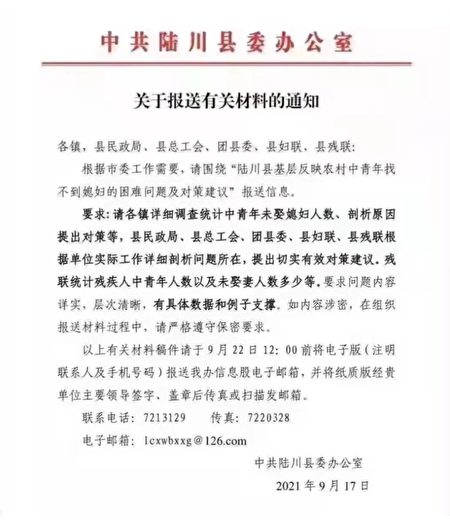[Epoch Times November 23, 2021](Epoch Times reporter Gao Miao comprehensive report) Recently, the “China Statistical Yearbook 2021” (hereinafter referred to as “Statistical Yearbook”) released on the official website of the National Bureau of Statistics of the Communist Party of China showed that China’s rural population exceeded 5.09 Among them, there are more than 264 million men, more than 245 million women, and nearly 20 million more men than women. This reflects that the imbalance of the sex ratio between men and women is particularly obvious in rural areas, with the most serious imbalances in Shanghai and Beijing.
According to the “Statistical Yearbook”, the current sex ratio of the rural population in China is 107.91, that is, if there are 100 women, there are 107.91 males, which exceeds the 105.07 of the total population in the seventh national census.
In terms of provinces, there are 31 provinces with a rural population sex ratio greater than 100, of which 14 provinces are greater than 110, including 110.07 in Shanxi, 112.26 in Inner Mongolia, 110.82 in Zhejiang, 110.94 in Fujian, 110.04 in Jiangxi, 111.34 in Hubei, 111.36 in Guangdong, and 111.83 in Guangxi. , Hainan 116.52, Chongqing 111.89, Yunnan 111.52, Ningxia 110.19, Shanghai and Beijing reached 130.93 and 120.21 respectively, the imbalance is the most serious.
Due to the imbalance between the male and female population in rural areas, the difficulty for rural men to marry has also become a major concern in various parts of China.
In September this year, a notice was circulated on the Internet that the Luchuan County Party Committee of Yulin City, Guangxi requested all towns and related units to count the number of young and middle-aged people who did not marry a wife, analyze the reasons and put forward countermeasures. The Paper also confirmed from the Luchuan County Party Committee Office that the notice is true and an internal notice.
In addition, the Civil Affairs Bureau of Xiangyin County, Hunan Province in October this year responded to the CPPCC Committee’s “Recommendations on Emphasizing the Difficulty of Choosing a Spouse for Older Rural Youths” and stated that it is necessary to educate and guide rural young women to “stay in their hometowns” in order to “work hard to reduce rural areas. The proportion of young men and women who are out of balance”. Many netizens criticized this “Proposal” for discriminating against women and disrespect for women.
The CCP implemented the “one-child policy” in 1979. The CCP government mentioned in many reports that there are 13 million abortions each year. However, the US State Department pointed out in the “2015 Human Rights Country Report” that China “the actual number of abortions per year is even higher.” high”. The U.S. State Department mentioned on page 55 of the 141-page report: “The National Health and Family Planning Commission of China reported that 13 million women in China abort unplanned pregnancies each year. But an official news media reported that at least An additional 10 million medical abortions are implemented in non-government clinics.” According to information provided by the US State Department, the number of abortions in China each year amounts to 23 million. The “one-child policy” directly led to a serious decline in the birth rate of China’s population.
After the Central Committee of the Communist Party of China announced in October 2015 at the Fifth Plenary Session of the 18th Central Committee to accelerate the launch of the “Comprehensive Second Child”, the “Three-Child Policy” was announced at the end of May this year, allowing couples to have three children in an attempt to “change the demographic structure.” To save the population crisis brought about by the declining birth rate and the aging society.
But experts point out that just allowing people to have more children will not have a significant effect on solving the population crisis. Hao Zhou, a senior economist at Commerzbank, told Reuters, “If the relaxation of the fertility policy is effective, then the current two-child policy should also prove to be effective.”
Joshua Rosenzweig, head of the China research team at the international human rights organization Amnesty International, believes that “the government has no right to control how many children people have. Instead of’optimizing’ its birth policy, China (the CCP) should Respect people’s choices and end any aggressive and punitive control.”
The Chinese people are not optimistic about the CCP’s “three-child policy.” The New York Times Chinese website reported that after the CCP announced the “Three-Child Policy” at the end of May, the CCP’s official media Xinhua News Agency immediately published a report on the Chinese social website Weibo titled “The Three-Child Policy Is Here Are You Ready?” According to a public opinion survey, about 22,000 netizens at one time responded that they chose not to consider it at all.
According to the report, many young people expressed angrily that it is already difficult for them to find a job and take care of themselves, let alone take care of one child (or three children). Working-class parents say that it is difficult to bear the financial burden of having more children. The investigation was deleted soon afterwards.
Huang Wenzheng, a senior researcher invited by the Globalization Think Tank (CCG) and a PhD in Biostatistics from Johns Hopkins University, pointed out that the main reason why China has fallen into the “low fertility trap” is that housing costs and education costs are too high, leading to childbearing age. The willingness of couples to bear children is generally sluggish. “For example, according to the “Report on the Housing Price-to-income Ratio of 50 Cities in the Country in 2019″, the housing price-to-income ratio in Shenzhen is 35.2. That is to say, for ordinary households in Shenzhen, it takes an average of 35.2 years to be able to afford it without eating or drinking. A house. The housing price-to-income ratios in Shanghai and Beijing are 25.1 and 23.9, respectively. High housing prices have greatly suppressed the willingness of urban couples to have children.”
Editor in charge: Gao Jing#
.
